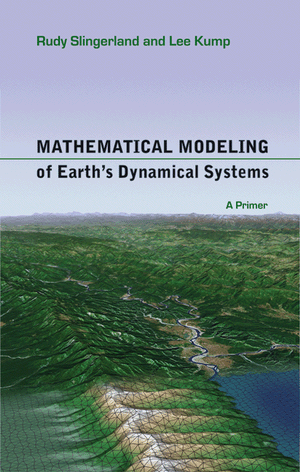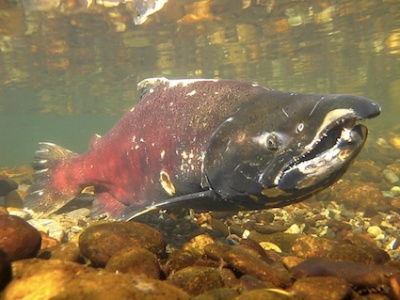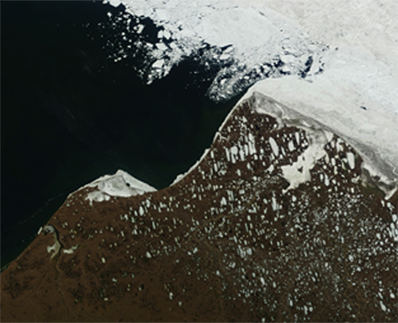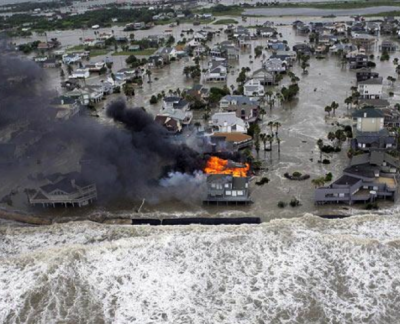Science spotlights
Science spotlights
Irreversible Peatland Subsidence Depends on Water Management
Science in the spotlight: November 2011 - December 2011

Understanding subsidence of peat-rich coastal areas due to bio-oxidation is of great importance, because of increased risk of flooding with rapid sea level rise, because of saltwater intrusion from nearby estuaries and lagoons, and because of net CO2 production with oxidation.
Detailed field observations of ground level and meteorological and soil conditions on peat-rich farmland nearby the Venice Lagoon in Italy over 2002-2006 show that with wetting and drying due to rainstorms significant, but reversible subsidence occurs. Peat expands with wetting and decreases as the water table drops subsequently. These elastic deformations due to pore pressure variations amount upto 5 mm over a few days to 2 weeks, and can be well modeled with a new numerical approach presented in the Journal of Geophysical Research paper (Zanello et al., 2011).
Irreversible loss over the period of measurement amounts upto 30 mm in 4 years. Subsidence has been ongoing over the last 70 years after this area was claimed for agricultural use. The exposed foundation of the small bridge on the photo illustrates how cumulative subsidence can be >1m, it now prohibits efficient drainage. A model quantifies the relationship between peat layer properties, water table (management) and temperature to predict bio-oxidation rates. It was found that most oxidation happens due to dry, warm conditions. The simulations indicate that for a given peat soil, oxidation is mostly influenced by a low water table levels. This result has important implications for hydrological management of peaty lowlands, less subsidence will occur under waterlogged conditions.
References
- Zanello, F., Teatini, P., Putti, M., Gambolati, G., 2011. Longterm peatland subsidence: experimental study and modeling scenarios in the Venice coastland. Journal of Geophysical Research, 116, F040002, doi:10.1029/2011JF002010
Links
- project website: Project website (mostly in Italian)..
New Modeling Textbook
Science in the spotlight: September 2011 - October 2011

The newly published textbook: “Mathematical Modeling of Earth's Dynamical Systems: A Primer” by Slingerland and Kump helps earth scientists build essential skills to represent Earth surface processes with mathematical and computational models.
The book aims at upper-level undergraduate students, graduate students, and scientists who want to learn how to abstract complex earth systems into sets of dynamic equations. It is clear that the authors do aim at an audience that is familiar with the principles of physics, chemistry, and geology, and expect some background in differential and integral calculus. But the authors stress that little prior modeling experience is needed to use this book; they want to instill a philosophy of science that values quantification as a way of gaining insight.
That philosophy rings true. The authors step aspiring modelers systematically through quantitative problem solving process. Firstly, get the physical picture clear while recognizing domains of interest and key factors, then write down the mathematical laws, be aware of the restrictive assumptions, check your units and boundary conditions and lastly verify, validate and solve your model.
Various relevant examples of processes and systems are provided with increasing complexity over the chapters. Slingerland and Kump offer problems over the entire Earth System Science domain in choosing groundwater flow, coastline evolution, sediment transport, radioactive decay, and carbon flux modeling problems as their rich set of examples. Every chapter has modeling assignments for eager modelers to try their newly acquired insight, or for teaching faculty to assign to their students. Slingerland and Kump are the “top chefs” who present a cookbook with their favorite basic recipes for earth surface modelers. Taste these, feed the inner quantitative modeler and enjoy.
The Princeton University Press quotes: "Written by two of the leading researchers in the field, Mathematical Modeling of Dynamical Systems is a must-read for all geoscientists, and not just students. This excellent primer offers bite-size gems of insight into the world of quantitative geosciences applications, covers both mathematical and modeling concepts, and offers practical exercises to build expertise. Course notes and methodologies will be improving across our academies."--James P. M. Syvitski, executive director, Community Surface Dynamics Modeling System
References
- Slingerland, R., Kump, L., 2011. Mathematical Modeling of Earth's Dynamical Systems: A Primer.
Princeton University Press. ISBN 978-0-691-14514-3.
Links
Where do Salmon thrive?
Science in the spotlight: June 2011 - July 2011

The Merced River in the Central Valley of California has been highly impacted by damming, gravel mining and placer mining over the last 150 years. River restoration projects along the Robinson Reach of the Merced River have focused on restoring the river to more natural conditions by excavating a 2.25km long single-thread, meandering channel with riffles and pools. Restoration was completed in January 2002. Dams in the upstream areas still dominate the flow conditions, with short releases of high water and mostly sustained low water. Two more extensive spring flood events with sustained overbank flows for several weeks occurred post-restoration.
A team of scientists from University of California, Santa Barbara, the California Polytechnical State University and the University of Wyoming used repeat observations of channel morphologies to condition flow simulations with FastMech-the Multidimensional Surface Water Modeling System developed by the USGS (a.o. Barton et al., 2005). Harrison and co-authors coupled the flow simulations to habitat criteria for Salmon spawning and rearing. Salmon prefer shallow riffles of ~50 cm for spawning, whereas optimal young salmon rearing habitat is in pools greater than 75 cm depth with lower flow velocities. Model simulations showed that substantial bar growth and migration occurred during the two flood events. Pointbars that were formed during flood are now favorable habitats at low flows, especially for spawning; 70% of the restored river stretch now has good habitat conditions for spawning. The coupled model predictions show that the restored channel has still less optimal conditions for Salmon rearing. Juvenile salmon need small-scale morphological features, which slow down the flow velocity.
References
- Harrison, L. R., C. J. Legleiter, M. A. Wydzga, and T. Dunne (2011), Channel dynamics and habitat development in a meandering, gravel bed river, Water Resour. Res., 47, W04513, doi:10.1029/2009WR008926.
- Barton, G. J., R. R. McDonald, J. M. Nelson, and R. L. Dinehart (2005), Simulation of flow and sediment mobility using a multidimensional flowmodel for the white sturgeon critical habitat reach, Kootenai River near Bonners Ferry, U.S. Geol. Surv. Sci. Invest. Rep., 2005‐5230.
Links
Retreating Arctic Coasts
Science in the spotlight: April 2011 - June 2011

The coastline in Arctic regions reacts to climate change with widespread increased erosion by 0.5 m per year. Coastal change is particularly dramatic in the Laptev, East Siberian and Beaufort Seas, where coastal erosion rates reach more than 14 m/year. Since around a third of the world’s coasts are located in the Arctic permafrost, coastal erosion may affect enormous areas in future. In general Arctic coasts react more sensitively to global warming than coasts in the mid-latitudes. Up to now these coasts have been protected against the eroding force of the waves, and warm sea water by sea ice cover. Due to the continuous decline in sea ice area extend, this protection is jeopardized.
Two thirds of the Arctic coasts consist of frozen sediments. And precisely these coasts are extremely hard hit by erosion. As a rule, Arctic regions are quite thinly populated. However, as nearly everywhere in the world, the coasts in the far north are important axes for economic and social life. The growing need for global energy resources as well as increasing tourism and freight transport additionally intensify anthropogenic influence on the coastal regions of the Arctic. For wild animal stocks, like the great caribou herds of the north, and the widespread freshwater lakes near the coast progressive erosion brings about significant changes in ecological conditions. More than thirty scientists from ten countries were involved in preparing the 170-page status report entitled “State of the Arctic Coast 2010”. The study was initiated and coordinated by the International Arctic Science Committee (IASC), the international joint project Land-Ocean Interactions in the Coastal Zone (LOICZ), the International Permafrost Association (IPA) and the Arctic Monitoring and Assessment Programme (AMAP) working group of the Arctic Council.
Links
- http://www.loicz.org/press/index.html.en
- http://www.arcticcoasts.org/
- PDF of report
- Article in 360 environment: As arctic sea ice retreats storms take toll on the land
Movies of coastal retreat can be found in the CSDMS EKT repository:
Boom-and-bust cycles of barrier island retreat
Science in the spotlight: December 2010 - April 2011

Barrier Islands, the low-lying sandy strips separated from the coast by a lagoon, are a favorite location to build beach resorts. Whereas a natural barrier system would steadily migrate with sea-level rise, barriers evolution is now dynamically coupled to human action to prevent storm erosion. CSDMS scientist Dylan McNamara, currently at the University of North Carolina, has been on the forefront of coupled modeling of barrier island physical processes and human factors such as hazard mitigation driven by market development.
McNamara’s model shows that barrier island are maintained at unnaturally low elevations and that this situation filters out the frequent small responses to storm events, but that the inherently instability creates longterm boom-and–bust cycles of barrier island retreat.
References
- McNamara, D. and Werner, B., 2008. Coupled Barrier Island-Resort Model: 1. Emergent instabilities induced by strong human-landscape interactions. Journal of Geophysical Research – Earth Surface, 113, F01016, doi:10.1029/2007JF000840.
- McNamara, D. and Werner, B., 2008. Coupled Barrier Island-Resort Model: 2. Tests and predictions along Ocean City and Assateague Island National Seashore, Maryland. Journal of Geophysical Research – Earth Surface, 113, F01017, doi:10.1029/2007JF000841.
